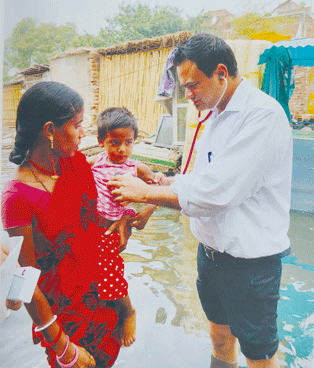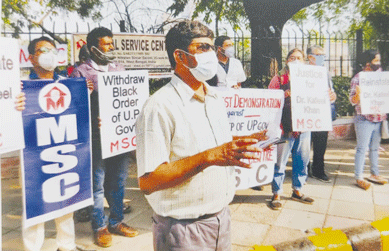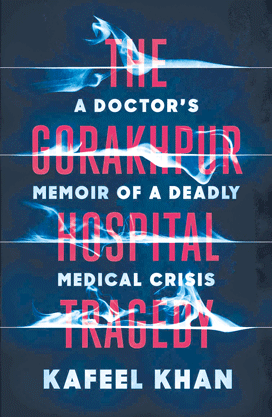When the State doesn’t know and doesn’t care the lives of people are always in jeopardy…
THIS is one book all Indians must read! The Gorakhpur Hospital Tragedy: A Doctor’s Memoir of a Deadly Medical Crisis’ (Pan Macmillan India, softcover, Rs499) is not an imaginary thriller but a real life accounting of what is happening increasingly in recent years in the lives of those who want to live a honourable life! This memoir offers so much insight into what happens to a doctor when the State decides to tighten the noose around his neck and turn his and his family’s life a nightmare -- as if the message going out loud and clear is keep quiet or see what we can do to you! For example, they can put you away in jail for any number of years with no questions asked – reasons are easily conjured up between the trinity of State bureaucrats, police and organisational admin persons seeking to save their skin. Dr Kafeel Khan’s account of the oxygen tragedy which took place in 2017 in a State-run Gorakhpur hospital is a familiar story and “The Gorakhpur Hospital Tragedy” by Kafeel Khan (softcover published by Pan Macmillan India, Rs500) makes for rare and chillingly brave, as heart-warming accounting of what happens to a doctor with a conscience – he gets framed. This is a non-fiction real life story we must read, evaluate and take cognisance of if we care about the kind of present and future we are slipping into. The oxygen shortage tragedy happened in 2017 UP’s Gorakhpur hospital and since it made the headlines the reading public is aware of the incident. The Gorakhpur hospital tragedy shows up the sorry story of healthcare in India, more so in small towns where life is a constantly uphill battle not just for patients seeking solutions to health problems, but even the doctors treating them who may have their hands tied up courtesy indifferent officials, failure of hospital managements, shortage

or mismanagement of funds, the root cause. On August 1, 2017 at the State-run Baba Raghav Das Medical College’s Nehru Hospital in Gorakhpur in Uttar Pradesh, over two days, more than 80 patients , 63 children and 18 adults , lost their lives for want of oxygen. Unbelievable? Think again. Such mishaps happen only too often in a country where health is more or less at the bottom of a government’s bucket of priorities. Crimes of corruption and rock bottom morality proliferate only to be rewarded not by the law but the powers that be! Justice can take a long, long time to surface. The Gorakhpur Hospital Tragedy’ is a first person account of a tragedy which happened and narrated by a doctor on the spot, first hailed as a hero then nailed falsely and thrown in jail to cover the sins of commission and omission of a bunch of administrative heads keen on saving their skin by hook or by crook. It is a disquieting straightforward account of exactly how the tragedy happened and why it happened. Members of the medical fraternity would do well to read it for future reference…there is much learn about a doctor’s life in this country sometimes hallowed, sometimes damned.
Doctors are hero-worshipped as penalized when something goes wrong courtesy medical or human errors of judgement, and sometimes against all odds to save a deteriorating situation. We have heard medical horror stories but rarely we get to hear about them in the nitty gritty like this one, in which a doctor decided he had to fight to clear his name and for the larger cause of justice.
Mind you, Dr Kafeel Khan was just a junior-most lecturer at the college’s paediatrics department but he went to extraordinary lengths to secure oxygen cylinders to perform emergency treatment for patients, and also rally staff to prevent as many deaths as possible. Then the number of quick deaths one after another hit the news headlines and the rest as we may say is medical history, how the entire healthcare infrastructure in this country (in some states more than others) is broken down and in dire need of repairs and rejuvenation — to save life rather than let it go as yet another statistic of those who died, don’t ask questions please if you don’t want to rock the boat! Of course, if you want to rock the boat, get ready to brave the stormy weather!

Never have I felt so ashamed as I have felt while reading this book. Dr Kafeel Khan’s last words etch themselves on the mind: “I dream of an equal India, where people are not looked down upon because of their economic status, caste or religion but are able t enjoy equal freedoms, rights and facilities, not the least of which is healthcare.” Here is a true life story all of us must read to make up our minds about where we want to be, on the side of the guilty or the side of the innocent – or sit on the fence like the cowards we are when we seek refuge in monumental silence. This is vital non-fiction reading for real progress of the mind and body, heart and soul!
(Reviewed by Tara Narayan)
Excerpted from `The Gorakhpur Hospital Tragedy’ by Kafeel Khan:
A DREAM AND A NIGHTMARE
IN August 2017, following the deaths of more than sixty infants at the state-run Baba Raghav Das Medical College in Gorakhpur, Uttar Pradesh, after the hospital’s medical oxygen ran out, I was suspended and jailed for more than eight months. The authorities denied that the hospital’s oxygen supply had been stopped, failed to identify the real culprits and instead blamed me for the fatalities. Between 10 to 12 August, I worked around the clock, trying to figure out a way to restore the supply of life-giving oxygen to the infants and children admitted in the wards and the intensive care unit of the hospital’s Department of Paediatrics. What happened over the course of those two to three days would soon lead to a life-and-death struggle of my own: a fight for my liberty, to remaining in the profession of healing and battle to live and work in the place where I was born – Gorakhpur, the home of my ancestors.
Little did I know at the time that some years after qualifying as a doctor and embarking on my medical profession, I would be forced to newly educate myself through bitter lessons learnt by witnessing negligence and dereliction of duty, corruption and vicious prosecution. It was only after navigating a series of crisis in the past four years that I could understand why I had to go through this incredible ordeal. I was meant to become more conscious and aware – for my own sake and that of society.
This book documents the arduous journey I was compelled to undertake after the events of August 2017, which upturned my life forever…..
AS a doctor and a long-term resident of Gorakhpur, I was aware of the recurring annual outbreak of encephalitis. Acute encephalitis syndrome of AES was an annual scourge that had, since 1978, claimed the lives of over 25,000 children in Uttar Pradesh and left more than one lakh permanently disabled. An acute inflammation of the brain, a case of AES is clinically defined as a person of any age, at any time of year, experiencing an acute onset of fever (for less than fifteen days) and a change in their mental status (symptoms include confusion, disorientation, coma or the inability to talk) and/or an onset of specific kinds of seizures.
It is an umbrella disease in which multiple aetiologies have been implicated, some established (such as Japanese encephalitis, herpes simplex and the enterovirus) and others not yet known. AES is a major public health problem due to its high fatality rate (20-30 per cent) and frequent neuropsychiatric damage (50-70 per cent). It is considered a medical and neurological emergency, requiring urgent consideration of key issues, including immediate life-support, the protocol for which is known in the medical profession as ABCD (airway – whereby the patient’s airway is to be cleared, breathing – most importantly, oxygen, high flow nasal cannula (HFNC) and mechanical ventilation; circulation using inotropic agents; and drugs — anti-epileptic, anti-edema and anti-pyretic medication – and institution of specific therapy).
It is a disease especially common amongst the underprivileged. Most AES-affected children come from poor, marginalized communities. The seven `P’s long associated with AES are population, poverty, poor nutrition (malnutrition), poor supply of safe drinking water, poor vaccination, poor hygiene and poor sanitation.
The virulent Japanese encephalitis is transmitted by mosquitoes as a vector from pigs to humans, but we have a vaccine for it. Still, most of the affected children belong to a low socio-economic stratum. I used to wonder how mosquitoes differentiated between rich and poor kids, or if it was because the health workers responsible for vaccination drives never visited these marginalized groups.
After finishing all my work at the ward and the OPD, I would teach nurses and junior doctors about the protocol for encephalitis treatment – how to handle a ventilator, talk to the patients’ relatives and administer medicines. I even took a course to improve my teaching and public speaking skills.
(from Prologue)
Timeline of Events
2017 –
10 August: Piped liquid medical oxygen runs out at the BRD Medical College’s Nehru Hospital.
11 August: The Uttar Pradesh government posts on its official social media account that no deaths have occurred due to lack of oxygen at BRD.
13 August: Sixty-three infants and eighteen adults die over the course of fifty-four hours after the oxygen shortage at the hospital.
22 August: The BRD Medical College suspends me from my post at the paediatrics department.
23 August: The Department of Medical Education of UP files an FIR against me and eight others under IPC sections 409, 308, 120B, 420, the Prevention of Corruption Act, Section 8 of the IPC and Section 15 of the Indian Medical Council Act.
28 August: I file a plea for anticipatory bail in the Allahabad High Court.
2 September: The UP Special Task Force arrests and sends me to Gorakhpur Jail.
2018
10 April: The Indian Medical Association comes out in my support, calling me a victim of conspiracy.
18 April: I write a ten-page letter detailing the events that transpired on the night of 10–11 August 2017 and ask for justice to be served in the Gorakhpur hospital tragedy case.
25 April: The high court releases me on bail after eight months in prison, after clearing me of the charges of medical negligence and corruption.
19 May: I visit the BRD Medical College and hand over a letter requesting the authorities to reinstate me.
10 June: My younger brother Kashif is shot three times in Gorakhpur by unidentified assailants.
14 August: An RTI response reveals that the hospital was facing a shortage of oxygen cylinders on the night of 10–11 August 2017. The BRD administration’s response states that around six cylinders were bought from other hospitals and I had arranged four oxygen cylinders on my own.
22 September: The UP police arrests me again and I am sent back to Gorakhpur Jail for allegedly creating a ruckus and forcibly treating patients at the Bahraich district hospital and criticizing the policies of the UP government. On the same day, my elder brother Adeel is arrested on charges of fraud and let go a month later.
3 November: I am released from prison.
2019
7 March: The Allahabad High Court orders the UP government to conclude their departmental enquiry against me within ninety days, acting on my writ petition to have my suspension revoked.
15 April: A probe panel led by Principal Secretary Himanshu Kumar submits their report, which absolves me of any charges of medical negligence, corruption and dereliction of duty, and acknowledges my efforts to control the crisis but finds me ‘guilty’ of private practice until 8 August 2016.
10 May: A division bench of the Supreme Court, comprising Justice Sanjay Kishan Kaul and Justice Indira Banerjee, orders for the enquiry regarding my suspension to be concluded in a timely manner and further directs the UP government to pay the subsistence allowances due to me.
31 July: A second suspension order is passed against me for forcibly treating patients at the Bahraich district hospital and criticizing the policies of the UP government while being in government service.
27 September: An internal enquiry committee of the hospital absolves me of the charges of medical negligence, corruption and dereliction of duty.
4 October: The UP government orders a fresh departmental enquiry into my role in the deaths of infants on the intervening night of 10–11 August 2017.
12 December: I deliver a speech against the controversial Citizenship Amendment on the campus of Aligarh Muslim University.
2020
29 January: The Uttar Pradesh STF arrests me in Mumbai, stating that my speech disrupted communal harmony and was likely to create a negative law-andorder situation. I am sent to Mathura Jail.
10 February: Aligarh district court orders my release.
13 February: The National Security Act is invoked against me for my anti-CAA speech at AMU.
24 February: The UP government orders a fresh enquiry, rejecting some points in the report submitted by the Himanshu Kumar-led committee.
1 September: The Allahabad High Court sets aside the UP government’s order holding me in preventive detention under the NSA.
17 December: The Supreme Court rejects the UP government’s plea to review the high court order quashing the charges under the NSA against me.
2021
30 January: I am added to the list of history sheeters by the UP government.
3 July: I file a writ petition against my first suspension order.
29 July: The high court questions the delay in ordering a fresh enquiry; also asks the UP government to justify why I am still suspended after four years.
6 August: The UP government informs the high court of its decision to withdraw the second enquiry and promises to complete disciplinary proceedings within three months.
27 August: The high court quashes the criminal proceedings against me for my speech at AMU in December 2019.
9 September: My second suspension in the Bahraich district hospital case is stayed by the high court.
15 September: The high court directs the UP government to conclude their enquiry against me within a month.
9 November: The Department of Medical Education of UP terminates me from my post at the BRD Medical College.
